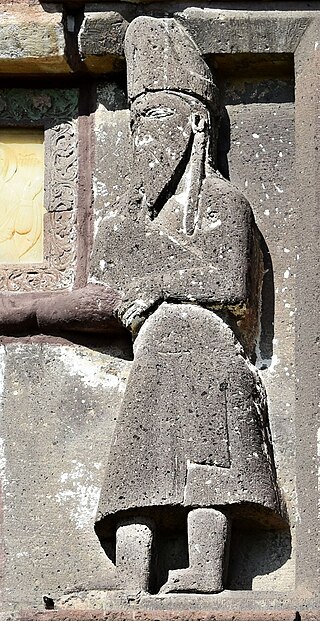
Salah ad-Din Yusuf ibn Ayyub, commonly known as Saladin, was the founder of the Ayyubid dynasty. Hailing from a Kurdish family, he was the first sultan of both Egypt and Syria. An important figure of the Third Crusade, he spearheaded the Muslim military effort against the Crusader states in the Levant. At the height of his power, the Ayyubid realm spanned Egypt, Syria, Upper Mesopotamia, the Hejaz, Yemen, and Nubia.

Tamar the Great reigned as the Queen of Georgia from 1184 to 1213, presiding over the apex of the Georgian Golden Age. A member of the Bagrationi dynasty, her position as the first woman to rule Georgia in her own right was emphasized by the title mepe ("king"), afforded to Tamar in the medieval Georgian sources.

The Ayyubid dynasty, also known as the Ayyubid Sultanate, was the founding dynasty of the medieval Sultanate of Egypt established by Saladin in 1171, following his abolition of the Fatimid Caliphate of Egypt. A Sunni Muslim of Kurdish origin, Saladin had originally served the Zengid ruler Nur ad-Din, leading Nur ad-Din's army in battle against the Crusaders in Fatimid Egypt, where he was made Vizier. Following Nur ad-Din's death, Saladin was proclaimed as the first Sultan of Egypt by the Abbasid Caliphate, and rapidly expanded the new sultanate beyond the frontiers of Egypt to encompass most of the Levant, in addition to Hijaz, Yemen, northern Nubia, Tarabulus, Cyrenaica, southern Anatolia, and northern Iraq, the homeland of his Kurdish family. By virtue of his sultanate including Hijaz, the location of the Islamic holy cities of Mecca and Medina, he was the first ruler to be hailed as the Custodian of the Two Holy Mosques, a title that would be held by all subsequent sultans of Egypt until the Ottoman conquest of 1517. Saladin's military campaigns in the first decade of his rule, aimed at uniting the various Arab and Muslim states in the region against the Crusaders, set the general borders and sphere of influence of the sultanate of Egypt for the almost three and a half centuries of its existence. Most of the Crusader states, including the Kingdom of Jerusalem, fell to Saladin after his victory at the Battle of Hattin in 1187. However, the Crusaders reconquered the coast of Palestine in the 1190s.

The Fifth Crusade (1217–1221) was a campaign in a series of Crusades by Western Europeans to reacquire Jerusalem and the rest of the Holy Land by first conquering Egypt, ruled by the powerful Ayyubid sultanate, led by al-Adil, brother of Saladin.

Al-Kamil was a Kurdish Muslim ruler and the fourth Ayyubid sultan of Egypt. During his tenure as sultan, the Ayyubids defeated the Fifth Crusade. He was known to the Frankish crusaders as Meledin, a name by which he is still referred to in some older western sources. As a result of the Sixth Crusade, he ceded West Jerusalem to the Christians and is known to have met with Saint Francis.

Al-Adil I was the fourth Sultan of Egypt and Syria, and brother of Saladin, who founded both the Sultanate of Egypt, and the Ayyubid dynasty. He was known to the Crusaders as Saphadin, a name by which he is still known in the Western world. A gifted and effective administrator and organizer, Al-Adil provided crucial military and civilian support for the great campaigns of Saladin. He was also a capable general and strategist in his own right, and was instrumental in the transformation of the decayed Fatimid Caliphate of Cairo into the Ayyubid Sultanate of Egypt.

The Kingdom of Georgia, also known as the Georgian Empire, was a medieval Eurasian monarchy that was founded in c. 1008 AD. It reached its Golden Age of political and economic strength during the reign of King David IV and Queen Tamar the Great from the 11th to 13th centuries. Georgia became one of the pre-eminent nations of the Christian East and its pan-Caucasian empire and network of tributaries stretching from Eastern Europe to Anatolia and northern frontiers of Iran, while also maintaining religious possessions abroad, such as the Monastery of the Cross in Jerusalem and the Monastery of Iviron in Greece. It is the principal historical precursor of present-day Georgia.

Ghiyath al-Din Kaykhusrawibn Kayqubād or Kaykhusraw II was the sultan of the Seljuqs of Rûm from 1237 until his death in 1246. He ruled at the time of the Babai uprising and the Mongol invasion of Anatolia. He led the Seljuq army with its Christian allies at the Battle of Köse Dağ in 1243. He was the last of the Seljuq sultans to wield any significant power and died as a vassal of the Mongols.

Nur al-Din Arslan Shah I was the Zengid Emir of Mosul 1193–1211. He was successor of Izz al-Din Mas'ud. He was appointed by the Ayyubids to this position in 1193. One of his slaves was Badr ad-Din Lu'lu', who became a famous ruler of Mosul, and a prominent patron of the arts.

Al-Malik al-Awhad Najm ad-Din Ayyub ibn al-Adil Abu Bakr ibn Najm ad-Din Ayyub was the third Ayyubid emir (prince) of the Diyar Bakr emirate, centered in Mayyafariqin, between 1200 and 1210 CE. He was the fourth eldest son of Sultan al-Adil I of Egypt.

The Georgian–Seljuk wars, also known as Georgian Crusade, is a long series of battles and military clashes that took place from c. 1048 until 1213, between the Kingdom of Georgia and the different Seljuqid states that occupied most of Transcaucasia. The conflict is preceded by deadly raids in the Caucasus by the Turks in the 11th century, known in Georgian historiography as the Great Turkish Invasion.

Zakare II Zakarian or Zakaria II Mkhargrdzeli, was an Armenian prince and a Court official of the Kingdom of Georgia holding the office of amirspasalar (Commander-in-Chief) of the Georgian army for Queen Tamar of Georgia, during the late 12th and early 13th centuries. He was a member of the Zakarid dynasty, and ruler of feudal lands in the Kingdom of Georgia.
Al-Mansur I Muhammad was the Ayyubid emir of Hama, son of Al Muzaffar Taqi ad-Din Umar and grandson of Nur ad-Din Shahanshah, brother of Saladin and Al-Adil. He ruled from 1191 to 1219.
Ivane-Qvarqvare Jaqeli-Tsikhisjvareli was a Georgian nobleman of the Jaqeli family, who served as eristavi ("duke") and spasalar ("constable") of Samtskhe in the early 13th century. Rising to prominence thanks to his loyal service to Queen-Regnant Tamar of Georgia, Ivane Jaqeli's long career spanned pivotal years in the history of medieval Georgia, through the "Golden Age" to the crisis and decline under the Mongol hegemony.
Ivane Akhaltiskheli was a Georgian military commander, and a Court official of the Kingdom of Georgia. He was member of the House of Toreli-Akhaltsikheli, and the brother of Shalva Akhaltsikheli.
Tamta Zakarian or Tamta Mkhargrdzeli was an Armenian Chalcedonian Christian noble woman of Kurdish descent, born at the court of queen Tamar of Georgia. She appears in only a few written sources, including contemporary histories by Kirakos Gandzaketsi and Vardan Areveltsi.

The Treaty of Jaffa, sometimes the Treaty of Jaffa and Tall al-ʿAjūl, was an agreement signed on 18 February 1229 between Frederick II, Holy Roman emperor and king of Sicily, and al-Kāmil, Ayyubid sultan of Egypt. It brought an end to the Sixth Crusade, led by Frederick, by restoring the city of Jerusalem and a few other territories to the Kingdom of Jerusalem, whose king at the time was Frederick's infant son Conrad.

Ivane I Zakarian was an Armenian prince, and a Court official of the Kingdom of Georgia holding the offices of Msakhurtukhutsesi (Majordomo) and Atabeg for Queen Tamar of Georgia during the early 13th centuries. He was a prince of the Zakarid dynasty, the son of Sargis Zakarian, and the younger brother and successor of Zakare II Zakarian. He was also ruler of feudal lands in the Kingdom of Georgia.
The Siege of Kars was a siege laid by the Kingdom of Georgia against the Emirate of Kars. It ended with the Georgian victory and annexation of Kars to the Georgian Kingdom.
















